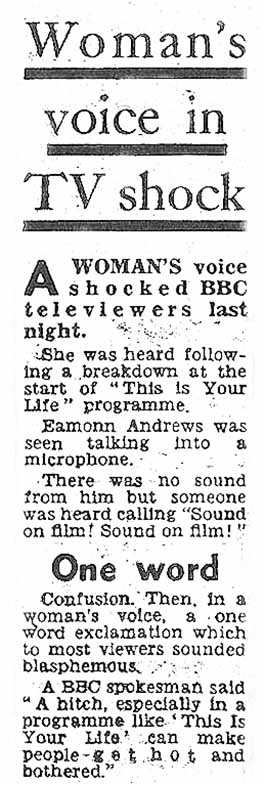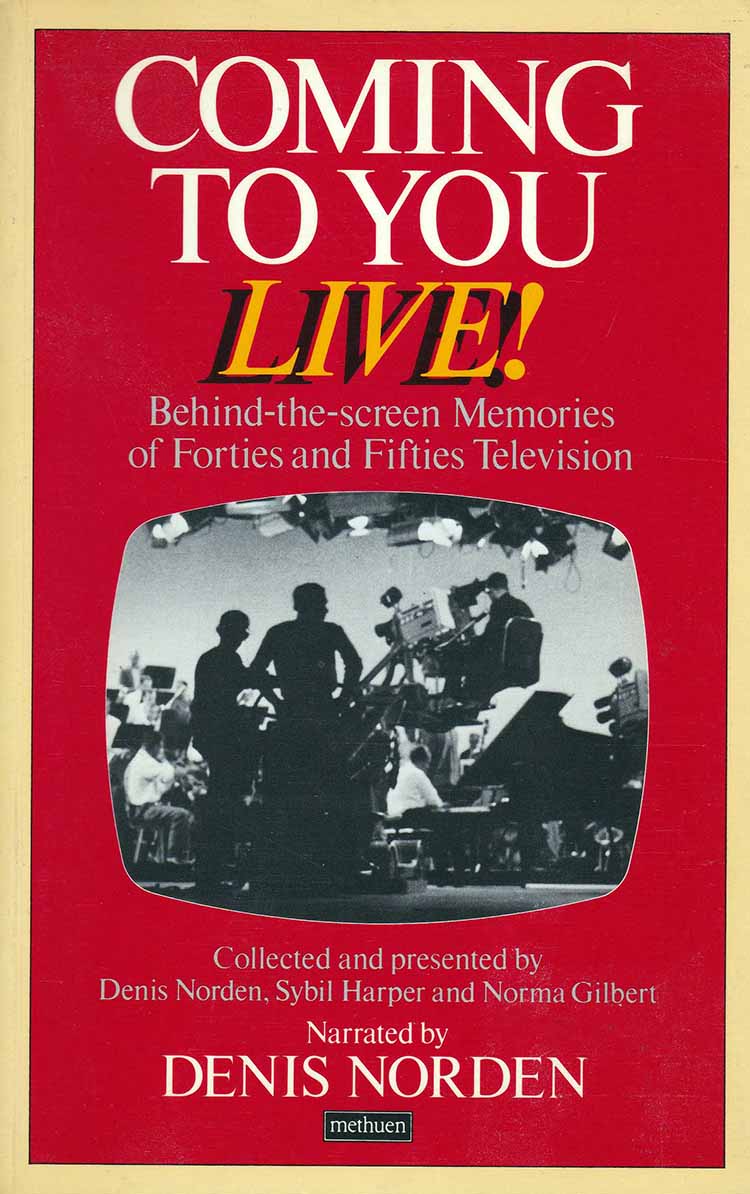Big Red Book
Celebrating television's This Is Your Life
31 October 1961

the producers who steered the programme's success
A woman's voice shocked BBC televiewers last night.
She was heard following a breakdown at the start of This Is Your Life programme.
Eamonn Andrews was seen talking into a microphone.
There was no sound from him but someone was heard calling "Sound on film! Sound on film!"
One Word
Confusion. Then, in a woman's voice, a one word exclamation which to most viewers sounded blasphemous.
A BBC spokesman said "A hitch, especially in a programme like This Is Your Life can make people get hot and bothered."

Yvonne Littlewood, the programme's director, recalls this edition of This Is Your Life in the book, Coming To You Live!...
I was quite a raw recruit when I took over This Is Your Life, which then used to be done by the BBC. It was around the time that the 'pick-up' – the bit where Eamonn nobbles the victim – should be a pre-filmed sequence.
They would film it every Monday morning and show the processed film that evening. But probably because that was then such a short time for processing to be done, there'd invariably be something technically wrong with the film.
Every single week I went through agonies. For six months, I sat in the gallery, cued the opening, on would come those shots of clouds This Is Your Life used to open with in those days, then I would mix through to the morning's film of the pick-up and something about it would be wrong. That six months felt like six years.
One programme I remember particularly was the week the subject was some worthy fellow who'd come down from Leeds and Eamonn picked him up, in a great crowd of people at Euston station. I mixed to the film of it, there was Eamonn with his mike, this gentleman gets off the train and walks along the platform, but nothing could be heard. No sound at all. I can remember yelling, 'Sound on film, where's the sound gone?' – then just babbling. I can recall thinking 'Not again! What shall I do? Shall I just fade the whole thing out? Stop it and start again? No, that's not possible, it's live. Shall I come straight in on him on the stage? But the curtains hadn't opened yet!'
In the end, as far as I can now remember, we just had to go straight over to the stage, because with no sound on the film it was all we could do. But that was just another of our weekly disasters and somehow I got through the show.
Afterwards, I was talking to Eamonn in his dressing-room, when Jacko – T Leslie Jackson, our producer – came in and said, 'I've had a reporter on the phone asking if I could confirm that viewers heard someone on the show blaspheming.'
I said, 'I don't remember anyone blaspheming.'
Jacko said, 'Well, I didn't think so, either. But he said that at the beginning of the show, they could hear some woman's voice saying, "Oh Christ, not again!"
Eamonn said, 'Come to think of it, I could hear your voice all day from somewhere.'
I said, 'Now you tell me...'
Next morning the papers were full of it. Of course, I was terrified. I thought, 'That's it, there's going to be a row about this.' But nothing happened the next day, and on Wednesday there was nothing either. When Friday came, I couldn't stand it any longer. I asked to see Mr Maschwitz, our boss, went in and there's tall Eric... a big cuddle and a kiss on the cheek, and, 'Hallo, how are you today, what's wrong?'
'I'm terribly worried, I don't know what to do. I thought you'd be sending for me on Tuesday.'
'What are you on about?'
I said, 'About Monday night and my voice being heard. Hasn't anybody said anything?'
'Oh that,' he said. 'Come to think of it, somebody did bring it up at Programme Review on Wednesday and I said, "Oh go on, that was just Yvonne asking for help from above."'
The minimum two days' requirement for film processing was one of the snags in 'telerecording', an early method of recording programmes by placing a film-camera in front of the television screen. Its other drawback was the resulting quality which, in the discreet phrase employed by engineers of the period, 'added loss to the picture'. Consequently, it was used mainly for archive purposes or the sale of historic programmes overseas; only rarely for re-transmitting domestically.